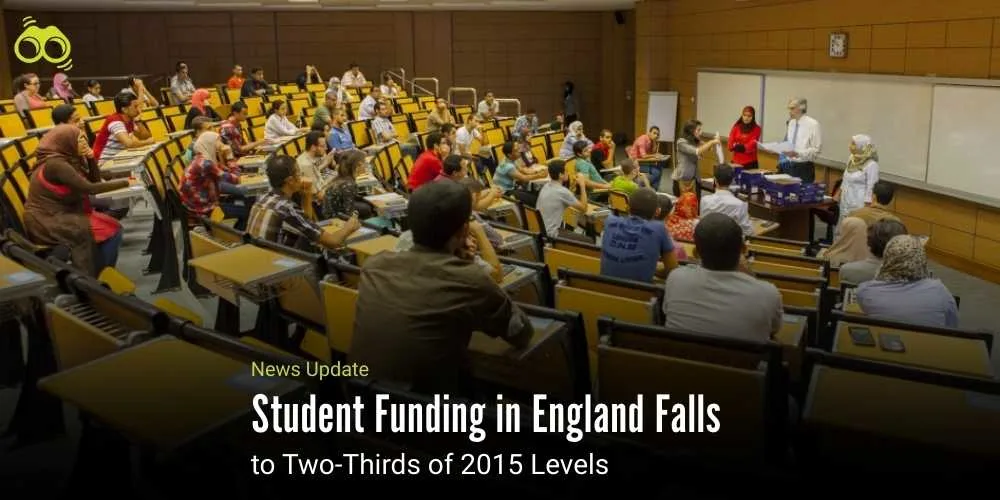English universities face course closures and deficits amid funding shortfall
Government levy on international students risks worsening university financial crisis
Financially, UK universities are under their most significant strain in decades. News of staff cuts, institutional drive from financial restrictions, and falling enrolments paints the pressure of the sector rippling through intense layers. According to analysis from Universities UK (UUK), a typical undergraduate in England receives only 64% of the teaching resources that would have been available in the academic year 2015-16 after adjusting for inflation.
This denotes a real decline in funding of £6.4 billion over a decade. Greatly, it portrays the scope of the difficulty faced. Government policy decisions compounded the mess. For instance, changes to tuition fees, amendments to pension payments for higher education staff, and the proposed levy on international students could reduce overall funding for higher education by £2.5 billion between 2024 and 2027, according to UUK. Universities are heavily dependent on international tuition fee revenues at a time when, according to Grant Thornton UK LLP, new immigration laws have already begun to impact the number of overseas students.
The first increase in the last decade in domestic tuition was approved by the government and hence set an annual fee moving forward at £9,535. The officials had announced that there would be incremental price increases depending on inflation over the next two years, which would have been around £9,900 by autumn 2026. Although the authorities believe that such reforms will trigger roughly £440 million annually, university leaders have contended that this is far short of covering the additional financial burdens imposed by rising costs on higher education.
This report by the UUK also raised alarm bells regarding the international student levy. The government has proposed a levy on overseas students, which it estimates will deprive universities of up to £780 million of annual income. According to the leaders, this amounted to greater damage to university financial sustainability than any benefits that would have accrued from the inflation-linked rise in home fees, or what the UUK report warns concerning the effects of a levy on international student fees, adding that many institutions already largely rely on this income from overseas students.
The impact of the government’s cuts has already been visible at universities. Nearly half of the UUK institutions had closed some of their courses, and several shut down whole departments. Approximately 80% stated that they were thinking of reducing spending on research. Recent announcements include Nottingham and Leicester, which are reviewing modern foreign language degrees, while Bradford announced closures in chemistry, biomedical sciences, and film and television. This clearly shows how much cuts to higher education funding continue to hurt university budgets and departments, with one in three institutions forecasting a deficit in budgets this current academic year in English universities.
Funding challenges for English universities in the academic year 2025-26 were further highlighted in this analysis. Economically adjusted university grants and tuition fees would, in real terms, not provide more than 64% of the available teaching resources during 2015-16. This decline in home student resources for teaching indicates the scale of the crisis in funding within English universities.
According to the Department for Education, it has put in place measures intended to secure the finances of the sector, which include raising the annual tuition fee cap as well as refocusing the Office for Students. However, university leaders have argued for more policy advice for UK higher education funding. They called for advocating services for funding reform in higher education and suggested that consultancy for financial sustainability in universities might benefit institutions in better planning. Experts also suggested courses of action through which the funding gap in UK universities would be filled, including targeted investment, new funding models, and the much-needed support for research. Some analysts even noted that there is likely an investment groundswell in financially stable universities since those with better reserves might adapt more easily.
The UUK analysis outlines how much reduced funding is for English universities indirectly, stating why the per student teaching funding in an English university has decreased after 2015‑16. With inflation increases, government support declines, and international tuition increasingly relied on, future university sector finances in England face serious challenges in 2025. In simple terms, this sector has come to a crossroads: without changing anything, universities will have to face further cuts, closures and reduced research capacity. But provided the right support is given, they could build university financial sustainability and deliver high-quality education to future generations.
Editor’s Note:
Inflation, cuts in government support, and declines in international enrolment have impacted the finances of universities. On scrutiny, UK higher education is undergoing serious financial strains at the moment. Furthermore, leaders have warned that between 2015 and 2016, the resources available for teaching per student have undergone a drastic drop, with many institutions already signalling that already are making cuts in courses, departments, and research.
It shapes how students learn and how staff teach, and is not a distant issue. Students are affected directly. Reduced budgets imply larger classes, fewer tutorials, and less feedback. Subject reductions arising from course closures will limit some career choices, particularly in modern languages and STEM areas. Access to support services such as libraries, labs, careers advice, and wellbeing provision is also pressuring students, making it harder for them to seek help when in need.
The decline in research earmarked funding further weakens teaching and innovation linkages—the latter vital in creating a strong learning experience. The challenges facing universities are just as dire. They are under heavy reliance upon international tuition income to balance their budgets. Any levy or policy change that lowers this income risks leaving these institutions immediately short. Rising costs, coupled with capped domestic fees, create uncertainty for long-term planning, with many universities living with constant deficits.
A persistent financial strain also affects local economies and skills pipelines, notably in regions where universities act as large employers and anchor institutions. The above solutions require public investment directed to specific purposes: to stabilise the environment for teaching, student services, and research while reforms are on the go. By adjusting tuition and grants to reflect actual costs, the quality of teaching could be safeguarded. There is smarter cost control through the shared services and digital efficiencies route, which should target reduced overheads. Professional education, micro-credentials, philanthropy, and industry partnerships could serve to diversify income via different avenues.
According to Skoobuzz, the UK's higher education sector is on the brink of a crisis. Without immediate intervention, students will face fewer options and diminished support, and universities will struggle to uphold quality standards. Strategic investment, fair policy implementation, and smart future planning are essential to safeguard the learning experience and restore the sector's long-term stability.
FAQs
1.Why has university funding per student in England dropped so much?
Funding per student has fallen because tuition fees have been capped for over a decade, while inflation has steadily increased costs. At the same time, government grants for teaching have been reduced, leaving universities with fewer resources to support each student. This real‑terms erosion of higher education funding explains why today’s students receive far less than those in the past.
2.How much less are English universities spending per student compared to 2015?
According to Universities UK (UUK) analysis, teaching funding per student in 2025–26 will be only 64% of the level in 2015–16 once inflation is taken into account. This represents a £6.4 billion real‑terms decline in funding over the decade, showing how much resources have dropped for undergraduates.
3.Will a levy on international students worsen university funding problems?
Yes. The government’s proposed international student levy is expected to remove around £780 million in annual income from universities. Leaders argue this would outweigh the benefit of inflation‑linked rises in domestic tuition fees, making institutions even more dependent on overseas income while threatening their financial sustainability.
4.Are English universities struggling financially because of funding cuts?
Universities are already under strain from reduced government support and capped tuition fees. Nearly half have closed courses, some have shut entire departments, and one in three institutions forecast a budget deficit for the current academic year. Cuts have also led to reduced research spending, showing the scale of the English university funding crisis.
5.How will the funding shortfall affect university teaching quality?
The shortfall means fewer teaching resources, larger class sizes, and less individual support for students. Course closures reduce subject choice, while cuts to research weaken the link between teaching and innovation. Overall, the real‑terms teaching funding decline risks lowering the quality of education and limiting opportunities for future generations.














0 Comments (Please Login To Continue)